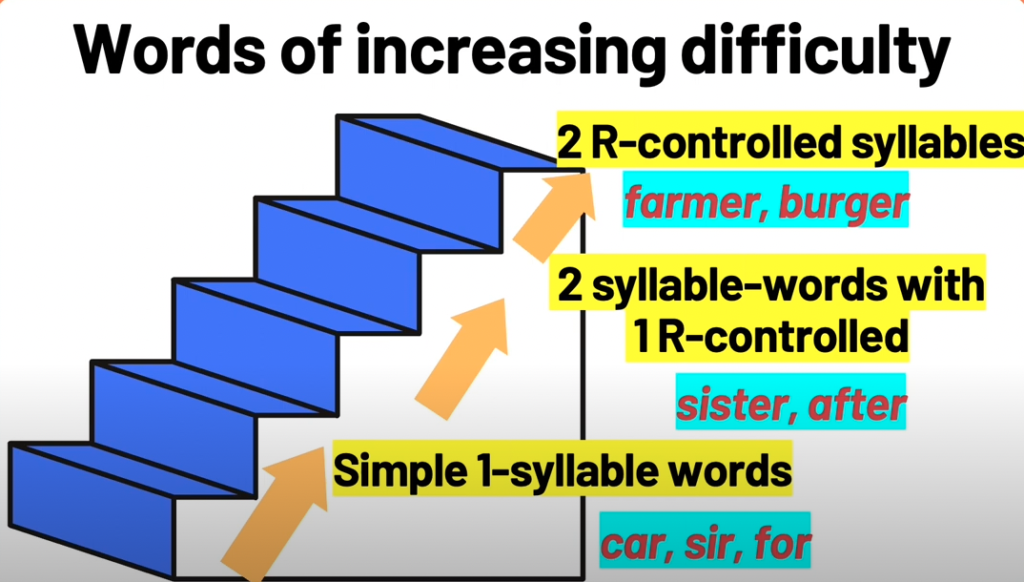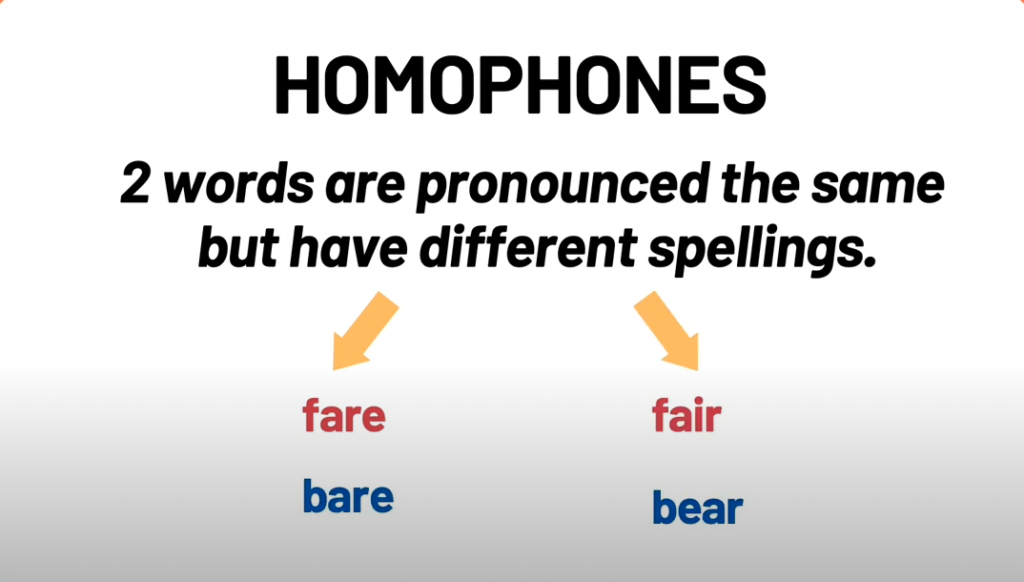R-controlled syllables is one of the six syllable types that we can find in the English language.
In this blog we have already covered open and closed syllables and silent e syllables, also called “magic e” or “bossy e” syllables.
If interested, you can check our articles and videos about these other syllable types here and here.
What are R-controlled syllables?
When the letter R follows a vowel, we are in the presence of a r-controlled syllable.
These syllables are normally referred to as “bossy r” syllables for younger students, as the R takes control of the vowel sound.

Let’s see how this happens exactly:
There are basically 3 types of r-controlled syllables:
Type #1: /ar/
Some sample words are:
car
far
farm
charm
Type #2: /or/
Some sample words are:
for
pork
fork
Type #3: /er/
Some sample words are:
her
fever
first
fur
nurse

As you may have noticed…
-
- /ar/ controlled syllables are normally represented by the ‘ar’ spelling.
- /or/ controlled syllables are normally represented by the ‘or’ spelling.
- /er/ controlled syllables are normally represented by the ‘er’, ‘ir’ or ‘ur’ spelling.
However, there are a few exceptions. For instance: work, word, doctor, actor, word, dollar, sailor.
How to teach r-controlled syllables?
When teaching r-controlled syllables to children, we shouldn’t teach these 3 types at the same time. We should go one at a time.
For instance, we start with the /ar/ syllable type first.
car, far, jar
Then we move on to the /er/ syllable type
her, sir, surf
Finally, we introduce the /or/ syllable type
for, sort, snort
We also introduce words of increasing difficulty to our children. We start with simple one-syllable words, as the ones we’ve seen before.

Then we move on to words two-syllable words that contain one r-controlled syllable (sister, after) or even two r- controlled syllables, such us burger or farmer.
More complex r-controlled syllables
Apart from the basic r-controlled syllable types we’ve seen so far, we also have COMPLEX R-CONTROLLED SYLLABLES.
These are syllables containing the /air/ sound or the /ear/ sound
The /air/ sound can hide behind different spellings, such us:
AIR: air, fair, pair
ARE: care, bare, fare
EAR: bear, pear, wear
The /ear/ sound can hide behind the following spellings:
EAR: ear, dear, fear, year
EER: deer, beer, cheer, steer
ERE: here, mere, severe
IER: pier, pierce, fierce

Homophones in R-controlled syllables
You might have noticed as well that these more complex r-controlled syllables contain lots of homophones. That is when you 2 words are pronounced the same, but have different spelling. For instance: fare/fair, bear/bare, dear/ dear, etc.

Conclusion
These more complex r-controlled syllables can be really confusing, so they shouldn’t be taught to our beginner readers yet. We should wait still until they learn to recognize and fully master the simple r-controlled syllables first to avoid cognitive overload and confusion.
In fact, we don’t recommend to even them right after the simple r-controlled syllables.
We would wait and introduce some other simpler phonics concepts first, as more complex r-controlled syllables can be really tricky.
Recommended resources
- Open and closed syllables post
- Magic E video-lesson
- Get a free r-controlled (Bossy R) syllable word list
Prefer to watch? Learn about r-controlled syllables on YouTube!

Hey there! I’m Laura – an author, YouTuber, blogger, and the creator of the “Learning Reading Hub” platform. I created this space to dive into the world of reading instruction and to shout from the rooftops about how vital it is to use the right methods for teaching reading. I’ve got a TEYL certification (Teaching English to Young Learners), plus a Journalism degree from the University of Navarra in Spain, along with a Master’s Degree in Communication.
I’ve always loved digging into research, jotting down my thoughts, connecting with people, and sharing what makes me tick. With a background in marketing, digital projects, and the education scene (especially language learning), I’m all about wearing different hats.
When my first kid needed to learn how to read, it opened my eyes to the challenges and complexities involved. This journey took me through a rollercoaster of self-teaching, eye-opening discoveries, and yeah, some letdowns too. There’s so much conflicting info out there, along with methods that just don’t cut it. And let’s face it, these issues are way too common.
Now, I’m all about channeling that passion (without sounding like a know-it-all!) and sharing my journey. My mission? Making it easier for those who are on the same path I once was.
My heart’s with my family and the amazing Learning Reading Hub project. I live with my husband and two little ones, raising them in a bi-lingual environment (English and Spanish).

